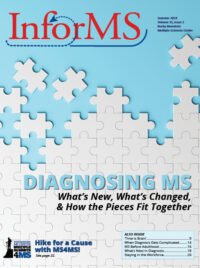Early and accurate diagnosis of MS is probably the most important component of MS treatment — getting patients on effective therapies as quickly as possible has a dramatic effect on their future.
Even with the progress outlined in this issue, ongoing research is working toward making the diagnosis process even better. Two areas in particular — finding reliable MS biomarkers, and identifying the earliest risk factors of MS — are key areas in the RMMSC’s research program at the University of Colorado.
BIOMARKERS: POSSIBLY THE EARLIEST INDICATORS OF MS
Biomarkers are what we call any indicator that can be used to define a disease or condition. For example, the presence of a particular antibody in your blood can tell doctors you have a particular illness that’s associated with that antibody. While there are many such things that point to the possibility of MS, we don’t yet know of a single definite indicator for MS.
“The patient who comes to us in the worst shape is easiest to diagnose,” said Dr. Enrique Alvarez, Clinic Director at the RMMSC at CU, and Principal Investigator at the RMMSC Biorepository for the Study of Neuroimmunological Disorders.
“The average patient, when they’re diagnosed, has 14 lesions, meaning they’ve had MS for some period of time. If they have something like 14 or even 30, 40, or 50 lesions, if they come in with some weakness, some numbness it kind of points you in a direction — I can hunt for those things.”
Patients with a lot of MS activity can be relatively easy to diagnose, but that means they’re already experiencing significant damage from MS.
“Other patients who come in with some tingling, some numbness, some fatigue, a random MRI — they have one or two lesions,” says Alvarez. “It might be a lesion that maybe even gives you some symptoms, but the first word of ‘multiple’ is the hardest criteria to meet. Somebody who comes in with a single set of symptoms, well that doesn’t make it ‘multiple’ so they don’t meet the criteria.”
In cases like this, neurologists can see things that look like they might someday lead to MS — but that doesn’t always lead to an early diagnosis, and can’t justify starting MS treatment. If biomarkers could be identified that clearly and reliably tell us when a patient has or is developing MS, treatment plans could be put in place to begin the fight against the disease.
“That’s where we are as a field,” says Alvarez. “You want this idea of having some biomarker, something that tells us you’re at a higher risk. Spinal fluid taps can be helpful, but we really don’t yet have a great biomarker to diagnose somebody with MS.”
RISE: IDENTIFYING RISK FACTORS THAT LEAD TO MS
The RISE MS study — named for “RISk factors in Early MS” — is looking into the earliest indicators of MS, in an effort to identify people who are at the highest risk of developing the disease.
Along with biomarkers, common symptoms that can be detected long before what we’d traditionally see as MS symptoms could give doctors a leg-up on early and effective treatments.
Dr. John Corboy, Co-Director of the RMMSC at CU, is also the Principal Investigator of the RISE MS study.
“We’re investigating whether we can identify risk factors that are associated with very early signs of multiple sclerosis, to potentially enable intervention as early as possible prior to clinical manifestations,” says Corboy.
“Adolescent or post-adolescent obesity, smoking, and Vitamin D deficiency have all been identified as early risk factors,” says Corboy. “These are things that are potentially alterable. Through this study, we may identify additional early risk factors that are alterable. With the RISE MS Study we are trying to understand what factors are associated with the earliest signs of MS.”
The RISE MS study aims to collect MRI data even before someone has symptoms of MS, by scanning first-degree relatives of people who’ve already been diagnosed.
“If you look at the MRI scans when people have their first clinical attacks, the average number of lesions on the scans is 15 to 35. Those lesions did not all happen instantaneously the week before their MRI scan was done,” says Corboy. Scanning people who haven’t yet developed MS, but may be at a higher risk to do so, could provide valuable information about the earliest signs of the disease.
“We’ll be looking at this highly at-risk population and using the most sensitive measure, an MRI scan, to try to identify what other factors are associated with changes seen on an MRI scan,” said Corboy. n






